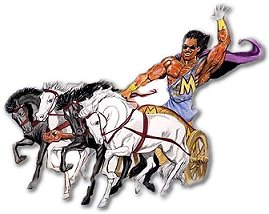
WELCOME TO MYTH MAN'S
AWARD-WINNING HOMEWORK HELP
MEDUSA THE GORGON
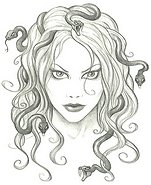


| There were three Gorgon sisters, Medusa, Stheno and Euryale. They were powerful and had wings, thus were able to fly. |
 CLICK TO ENLARGE |
| Even though the ancient Greek vase painters visualized Medusa and her sisters as being born with the form of monsters, Medusa later began to be described as a beautiful, albeit terrifying, woman with venomous snakes as hair. |
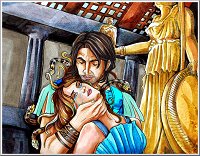 CLICK TO ENLARGE |
| To punish Medusa for having had relations inside her temple, Athena transformed her into the beast with the writhing snake hair. |
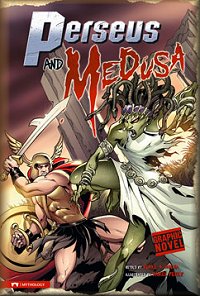 |
| Perseus was able to slay Medusa by looking at her reflection from the mirrored shield, rather than directly at her. This prevented him from being petrified like the rest of the heroes who tried to kill the beast. Thus he was able to behead her. |
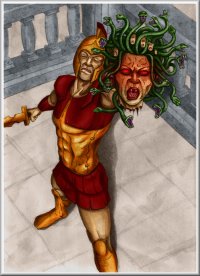 CLICK TO ENLARGE |
| Perseus used Medusa's severed head to accomplish many heroic deeds, including rescuing Princess Andromeda by turning into stone the sea monster that was about to devour the beautiful maiden. |
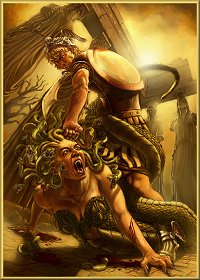 CLICK TO ENLARGE |
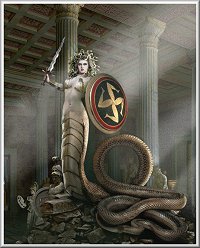 CLICK TO ENLARGE |
 CLICK TO ENLARGE |
Looking directly upon her would immediately transform any onlookers into stone.
Talk about a bad hair day!
But it wasn't always that way. Most poets and writers say that she was the daughter of Phorcys and his sister Ceto, who were ancient monsters and deities of the sea.
The family tree of Phorcys includes the famous Graeae (The Grey Ones), the Hesperides, who guarded the golden apples, the sea monster Scylla, and countless more fantastic beings.
Talk about an infamous lineage...Must have made for some fascinating family reunions!
There were three Gorgon sisters, Medusa, Stheno and Euryale. They were powerful and had wings, thus were able to fly at terrific speeds.
They were described as girded with serpents, gnashing their enormous teeth and vibrating their tongue to horrify their victims.
The three Gorgons were said to live in the Western Ocean, in the vicinity of Night and the Hesperides, but later writers place them in Libya.
Out of the three sisters, only Medusa was said to be mortal. The other two were deathless.
(Many students ask me why Medusa was mortal, as opposed to her sisters, who could not be killed. That detail probably exists so that the hero Perseus could slay her - if Medusa was immortal like her sisters, our hero would not have been able to perform his amazing feat.)
Their name, Gorgon, translates from the Greek into Terrible, Fierce, Grim. One look at their faces and you would know why!
Even though the ancient Greek vase painters visualized Medusa and her sisters as being born with the form of monsters, Medusa later began to be described as a beautiful, albeit terrifying, woman with venomous snakes as hair.
How did this beautiful maiden become such a terrible monster?
Well, it was through no fault of her own! You see, Poseidon, the Lord of the Sea and brother to Zeus, laid eyes on the gorgeous young woman and immediately wanted to possess her.
However, Medusa was a chaste woman and wanted nothing to do with Poseidon. The poor woman did her utmost to escape from the determined god, but to no avail, he persisted in his attempt to seduce her.
She finally took refuge in the temple of Athena, hoping that the virgin goddess would protect her, but Poseidon paid no heed to the surroundings and proceeded to have his way with the unwilling victim.
To punish Medusa for having had relations inside her temple, Athena transformed her into the beast with the writhing snake hair. Not fair at all, if you ask me!
Here is the ancient poet Ovid's description of the violation and resulting punishment of Medusa:
"Her beauty was far-famed, the jealous hope of many a suitor, and of all her charms her hair was loveliest; so I was told by one who claimed to have seen her. She, it's said, was violated in Minerva's (Athena's) shrine by the Lord of the Sea (Rector Pelagi) [Poseidon].
"Jove's (Zeus') daughter turned away and covered with her shield her virgin's eyes. And then for fitting punishment transformed the Gorgo's lovely hair to loathsome snakes. Minerva [Athena] still, to strike her foes with dread, upon her breastplate wears the snakes she made."
The way Ovid tells it, her slayer Perseus describes Medusa's punishment by Athena as just and well earned. Go figure.
Many warriors tried unsuccessfully to slay the monster Medusa, but all were turned to stone inside her lair. The monster's reputation grew with each victim.
The great hero Perseus was sent to deliver her head by King Polydectes of Seriphus, an impossible task indeed.
To assist Perseus in his conquest he received the following essential items:
1) A sword from the smiths god Hephaestus
2) Lord of the Underworld Hades' helmet of invisibility
3) Gold winged sandals from the messenger god Hermes
4) A mirrored shield from Athena, goddess of wisdom
Perseus was able to slay Medusa by looking at her reflection from the mirrored shield given to him by Athena, rather than directly at her. This prevented him from being petrified like the rest of the heroes who tried to kill the beast. Thus he was able to behead her, using the magnificent sword specially crafted by Hephaestus.
Because Medusa was pregnant by Poseidon, upon her decapitation Pegasus, the wonderful winged horse, and Chrysaor, a golden sword-wielding giant, sprang forth from her corpse.
Pegasus was given his name from the springs (pegai) of Oceanus, where Medusa was born.
The enraged sisters of Medusa, Stheno and Euryale, gave chase but were unable to capture Perseus, even though they came mighty close to killing the hero. If not for Hades' helmet of invisibility and Hermes' golden wings, Perseus would have been doomed.
Perseus used Medusa's severed head to accomplish many heroic deeds, including rescuing Princess Andromeda by turning into stone the sea monster that was about to devour the beautiful maiden. You can read about that fabulous tale at my Perseus homework help page, under the Heroes heading.
Here are some subsequent uses of Medusa's head:
1) A tradition in Athens held that the head of Medusa was buried under a mound in the Agora, the central city square.
2) Athena herself was said to have placed the head in the center of her shield or breastplate, called the Aegis.
3) Athena gave to Heracles (Hercules) a lock of Medusa, concealed in an urn, and it had a similar effect upon any beholder as the head itself. Heracles used the lock in his battle against Lacedaemon, gifting the lock of hair to Sterope, daughter of Cepheus, to protect her home town.
4) According to Ovid, while travelling in northwest Africa, Perseus flew past the Titan Atlas, who stood holding the sky aloft as punishment for rebelling against Zeus. When the Titan tried to attack him, Perseus transformed him into stone, creating the Atlas mountains.
5) When Perseus laid down briefly Medusa's head at the Red Sea, corals were said to have been formed of her blood that had spilled onto the seaweed by the shore.
6) The poisonous vipers of the Sahara desert were said to have sprung up from drops of Medusa's blood that had been spilled.
7) The blood of Medusa also spawned a horned dragon-like beast with a snake-headed tail, called the Amphisbaena.
8) Finally Perseus flew to Seriphos, where his mother was facing a forced marriage to King Polydectes. This man was subsequently turned to stone by the gaze of Medusa's severed head.
At the end, Athena placed Medusa's head on her shield or breastplate, and it was called the Aegis.



| Medusa was a Gorgon, a monster said to have the face of a hideous human female with snakes in place of hair. Looking directly upon her would immediately transform any onlookers into stone. |
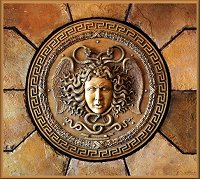 CLICK TO ENLARGE |
| Out of the three sisters, only Medusa was said to be mortal. The other two were deathless. |
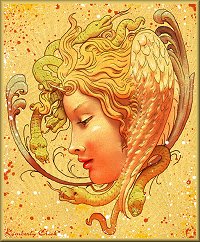 CLICK TO ENLARGE |
| Because Medusa was pregnant by Poseidon, upon her decapitation Pegasus, the wonderful winged horse, and Chrysaor, a golden sword-wielding giant, sprang from her corpse. |
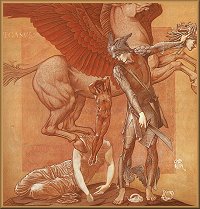 CLICK TO ENLARGE |
| Athena herself was said to have placed the head in the center of her shield or breastplate, called the Aegis |
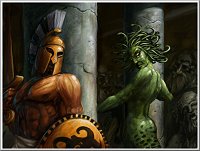 CLICK TO ENLARGE |
| Athena gave to Heracles (Hercules) a lock of Medusa, concealed in an urn, and it had a similar effect upon any beholder as the head itself. |
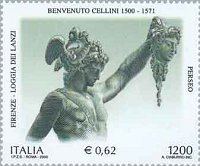 CLICK TO ENLARGE |
HOMEWORK HELP
[HOME] [MYTHOLOGY'S
EFFECTS ON MODERN SOCIETY] [OLYMPIANS]
[GALLERY] [MAJOR
GODS] [MINOR
GODS] [HEROES]
[CONTACT]
[LOVE STORIES]
[MYTH OF THE
MONTH] [FUN
STUFF] [CREATURES]
Web, myth narration and graphics created and
maintained by Nick Pontikis
Copyright © 1995 Nick Pontikis
Thanasi's Olympus Greek
Restaurant
Copyright 1999 mythman.com
greekmythologytoday.com
mythmaniacs.com
The Myth Man persona copyright 1988 Nick Pontikis